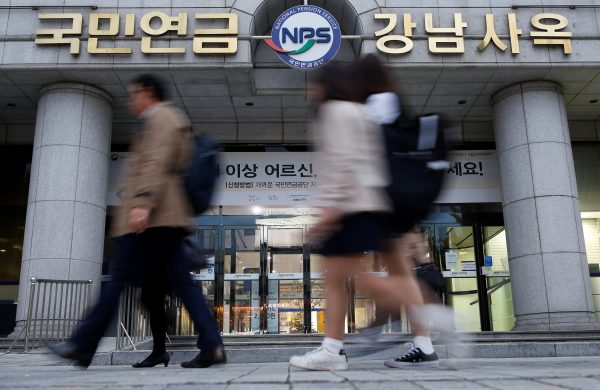The NPS faces long-term sustainability concerns and should look to fix them sooner rather than later. Options include reducing benefits, increasing the contribution rate, increasing the retirement age and increasing the target for investment returns.
Reducing benefits is not a feasible option as the current benefit level is already very low and the NPS is criticised for being a ‘pocket money’ pension system. The NPS’s maximum replacement ratio — pension income over lifetime average income — is 40 per cent. This number is based upon the assumption that a retiree works and contributes for 40 years. But the maximum is very rarely achieved — the average number of working years in South Korea is actually far less than 40 years, bringing the average replacement ratio to less than 30 per cent.
Increasing the retirement age and the contribution rate are the clear choices, but they incur fierce resistance from the public. While enhancing investment return does not have this problem, it still requires sophisticated investment capacity. Given that the current NPS fund is large and will continue growing for the next 20 years, the impact of investment return enhancement is powerful. Roughly speaking, a 1 per cent per annum increase in investment return would offset a 2 per cent increase in the contribution rate. A 4 per cent per annum increase in investment return would theoretically solve the NPS fund’s sustainability problems.
The problem is that achieving a 4 per cent per annum increase in investment return is almost impossible, especially for a fund this large. Enhancing investment returns should still be pursued as it will reduce the required increase in the contribution rate for the long-term sustainability of the NPS.
The first thing the NPS should do to enhance returns is transform its domestically biased portfolio into a more globally diversified portfolio. Diversification allows returns to be enhanced without increasing the risk profile of the fund. Currently, more than 60 per cent of the NPS fund is in domestic assets.
Yet, as more foreign assets are included in the portfolio, the NPS will be exposed to higher currency risk and will have to develop its risk management capacity. The US dollar can be a good hedging asset for the NPS — the South Korean won to US dollar exchange rate tends to co-vary negatively with foreign asset prices, especially in the long term.
Diversification aside, there is another compelling reason why the NPS should reduce its domestic asset investment share. The NPS faces the ‘big fish in a small pond’ problem, it’s overwhelmingly large relative to the domestic asset market. It already owns about 7 per cent of South Korean stock markets and 18 per cent of South Korean bond markets. People are concerned about the excessive influence of the NPS on the domestic economy and asset markets, particularly due to its substantial holdings of South Korean company stocks and its vulnerability to exogenous political and social pressures.
Like other organisations, having the right governance structure is key to the NPS becoming a savvy global investor. The most important part of the NPS governance structure is its highest governing body — the Fund Management Committee (FMC). The FMC currently has good representation among different interest groups, but it has too many members and too little expertise on investment issues.
If the NPS wants to improve its return generation and risk management capabilities, it should reinvigorate the FMC so that it can actually discuss, debate and develop solutions to different investment and risk management issues.
The capability of the NPS Investment Management (NPSIM) team is also limited due to high turnover of investment staff and a somewhat discouraging work environment brought about by a heavy administrative work burden. Its operating budget is tightly controlled by the government because the NPS is a public entity. Considering that a small percentage of extra return on the NPS fund means a substantial amount of money generated, allocating enough funding to the NPSIM to improve its investment capacity is the sensible thing to do.
Due to demographic change and a global low interest rate environment, most pension systems around the world face the same challenge of sustainability. Different systems need different solutions, but for the NPS wise investment is a critical part of the solution. The later it strengthens its investment capabilities, the greater the burden that will be transferred to future generations.
Sunghwan Shin is President of the Korea Money & Finance Association and Professor of finance at Hongik University, Seoul.

